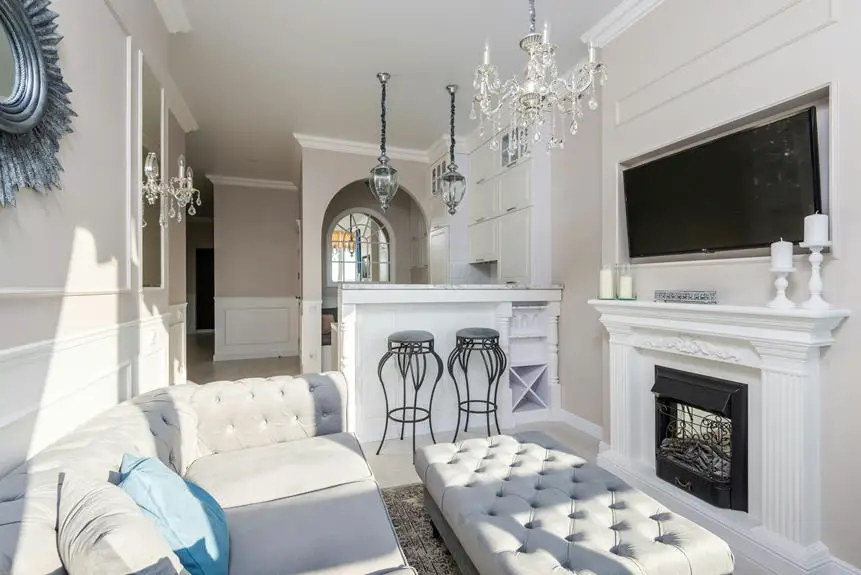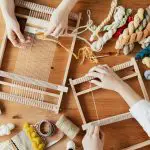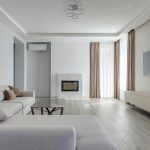When considering batiste for upholstery, it's important to weigh its lightweight and breathable qualities against its durability. Sure, its soft texture can elevate the look of your space, but you might wonder how it holds up in high-traffic areas or against spills. Understanding the pros and cons can guide your decision, especially if you're aiming for a balance between aesthetics and practicality. So, what factors should you consider before making that choice?
Table of Contents
What Is Batiste Fabric?
Batiste fabric is a lightweight, finely woven textile often made from cotton or a cotton blend, perfect for delicate upholstery projects. This material's soft texture and smooth finish make it an excellent choice for adding a touch of elegance to your furnishings. You might find it particularly appealing for items like curtains, cushion covers, or even chair upholstery where a gentle drape and refined look matter.
When working with batiste, you'll appreciate its versatility. It's easy to sew, allowing you to create intricate designs without much hassle. You can also dye it in various colors, making it a great option for customizing your projects to match your aesthetic.
Although batiste is lightweight, it still offers durability, especially when treated properly. It's essential to consider its care requirements, as some finishes can be sensitive to water or high heat.
Characteristics of Batiste
Known for its lightweight and smooth texture, batiste fabric also boasts characteristics that make it particularly suited for various upholstery applications. One of its most appealing features is its breathability. Because batiste allows air to circulate, it keeps upholstered furniture comfortable, especially in warmer climates. This quality can enhance your sitting experience and help regulate temperature.
Batiste's soft feel is another significant advantage. When you touch it, you'll notice its gentle texture, making it a great option for items like cushions and chair covers. This softness can add a touch of luxury to your space without overwhelming your senses.
Additionally, batiste is available in a wide range of colors and patterns, allowing you to express your personal style easily. Whether you prefer classic prints or modern designs, you can find batiste that fits your vision.
Lastly, batiste's lightweight nature makes it easy to handle and work with during upholstery projects. You'll find that sewing and fitting it to furniture is manageable, giving you more freedom to create unique pieces. With these characteristics, batiste stands as a versatile choice for various upholstery needs.
Durability and Strength
When choosing batiste for upholstery, you'll want to consider its durability and strength.
This fabric can withstand high traffic areas, making it a smart choice for busy households.
Plus, its resistance to wear and tear ensures your furniture stays looking fresh for longer.
Material Composition Analysis
Analyzing the material composition of batiste reveals its impressive durability and strength, making it an ideal choice for upholstery applications. Batiste is typically made from cotton or a cotton-blend, which contributes to its robust nature while maintaining a lightweight feel. This combination ensures it can withstand regular use without easily fraying or tearing.
The tightly woven fabric structure of batiste enhances its resilience, providing a smooth finish that resists snagging. This quality is essential for upholstery, as it minimizes wear and keeps the fabric looking fresh longer.
You'll also appreciate that batiste's breathable properties help prevent moisture build-up, reducing the risk of mold or mildew in humid environments.
Moreover, batiste can be treated with various finishes to improve its stain resistance and overall longevity. These treatments further enhance its suitability for high-use furniture pieces.
While it's not the thickest upholstery fabric available, its unique blend of softness and strength makes it an attractive option for both comfort and durability.
Longevity in High Traffic
Batiste's impressive durability and strength make it particularly effective in high-traffic areas, where the fabric needs to endure frequent use without showing signs of wear. When you're considering upholstery options, you want something that can handle the hustle and bustle of daily life. Batiste fits the bill perfectly, maintaining its integrity even with constant exposure to foot traffic, pets, and everyday activities.
You'll appreciate how resilient this fabric is, as it can withstand the rigors of everyday use. Whether it's a busy living room, a family den, or a crowded office, Batiste holds up remarkably well. Its lightweight nature doesn't compromise its strength; instead, it allows for easy handling and installation while ensuring long-lasting performance.
Moreover, Batiste's ability to retain its color and texture over time means you won't have to worry about fading or fraying. This longevity makes it a smart choice for anyone looking to invest in upholstery that will last. So, if you're thinking about upholstery options for high-traffic areas, Batiste offers the durability and strength you need to keep your furniture looking great for years to come.
Resistance to Wear and Tear
Because of its exceptional resistance to wear and tear, Batiste proves to be an ideal choice for upholstery in environments that demand strength and durability. When you're choosing fabric for areas that see heavy use, you want something that stands up to the daily grind. Batiste's lightweight nature doesn't compromise its durability; instead, it offers a balance between softness and strength.
Here are three key reasons why Batiste is a solid option for upholstery:
- Abrasion Resistance: Batiste can withstand friction and rubbing, making it less likely to develop unsightly wear marks over time.
- Stain Resistance: Its ability to repel spills and stains means you'll spend less time worrying about accidents, keeping your upholstery looking fresh.
- Color Retention: Batiste maintains its vibrant colors even after multiple washes, ensuring your furniture continues to look stylish and inviting.
Pros and Cons for Upholstery
When choosing batiste for upholstery, you'll find both appealing advantages and notable drawbacks to consider.
One major pro is its lightweight and breathable nature, making it an excellent choice for projects where comfort is key. Batiste also boasts a smooth texture, which can lend a sophisticated look to your furniture. Additionally, it's often available in a variety of colors and patterns, giving you plenty of design options.
However, there are some significant cons to keep in mind. Batiste isn't as durable as heavier fabrics, which could lead to wear and tear over time, especially in high-traffic areas. It may not hold up well against spills or stains, making it less suitable for families with kids or pets. You might also find that it can fade more quickly when exposed to sunlight compared to other upholstery materials.
Ultimately, while batiste can add a delicate touch to your decor, it's essential to weigh these pros and cons against your specific needs and lifestyle. Consider how much use and care your upholstered items will require before making a decision.
Care and Maintenance Tips
Caring for batiste upholstery requires regular maintenance to keep it looking fresh and vibrant. Since batiste is a lightweight fabric, it can show wear and tear more easily than heavier materials. Here are some essential care tips to help you maintain your batiste furniture:
- Regular Dusting: Use a soft cloth or a vacuum with a brush attachment to remove dust and debris. Doing this weekly can prevent buildup and keep the fabric looking clean.
- Spot Cleaning: For spills and stains, act quickly. Blot the area with a clean cloth and a mild soap solution. Avoid rubbing, as this can damage the fibers. Rinse with a damp cloth and let it air dry.
- Avoid Direct Sunlight: Position your batiste upholstery away from direct sunlight to prevent fading. Use curtains or blinds to shield your furniture from harsh UV rays.
Alternative Upholstery Fabrics
When you're considering upholstery options, don't overlook the benefits of alternative fabrics.
Natural fiber choices like cotton and linen offer durability and a timeless look,
while synthetic options can provide easy maintenance and vibrant colors.
Exploring these materials can help you find the perfect fit for your space.
Natural Fiber Options
Natural fibers like cotton, linen, and hemp offer sustainable and stylish alternatives for upholstery that enhance both comfort and aesthetic appeal.
These materials not only contribute to an eco-friendly home but also provide distinct qualities that can transform your space.
Here are three compelling reasons to consider natural fibers for your upholstery:
- Breathability: Natural fibers allow air to circulate, keeping your furniture comfortable during all seasons. You won't have to worry about overheating in the summer or feeling cold in the winter.
- Durability: While they're soft to the touch, natural fibers can withstand wear and tear. Linen, for example, becomes softer with each wash, making it a great choice for frequently used items.
- Hypoallergenic Properties: If you or your family members have allergies, natural fibers can be a better option. They're less likely to harbor dust mites and other allergens compared to synthetic fabrics.
Synthetic Fabric Choices
Synthetic fabrics offer a wide range of vibrant colors and patterns, making them an appealing choice for upholstery that can elevate any interior design. These materials, like polyester, nylon, and acrylic, are known for their durability and resistance to stains, fading, and wear. You'll find that they're ideal for high-traffic areas where longevity is essential.
When choosing synthetic fabrics, consider your lifestyle. If you have pets or young children, look for options that are easy to clean and maintain. Fabrics like microfibers can resist spills and are generally simple to wipe down, giving you peace of mind. Additionally, these materials often mimic the look and feel of natural fibers, allowing you to enjoy the aesthetic without compromising on practicality.
Another advantage is the affordability of synthetic fabrics. They tend to be less expensive than their natural counterparts, allowing you to achieve a stylish look without breaking the bank. Plus, with advancements in technology, many synthetic options offer breathability and comfort, making them suitable for any space.
Embrace the versatility of synthetic upholstery fabrics and transform your home with ease.
Frequently Asked Questions
Can Batiste Be Used for Outdoor Upholstery Projects?
Batiste isn't ideal for outdoor upholstery projects. It's lightweight and delicate, which means it won't withstand the elements well. Instead, consider using more durable, weather-resistant fabrics specifically designed for outdoor use.
Is Batiste Fabric Suitable for Heavy-Use Furniture?
Batiste isn't ideal for heavy-use furniture due to its lightweight nature. You'll want something sturdier like canvas or denim for durability. Consider your lifestyle and choose fabrics that can withstand daily wear and tear.
What Colors and Patterns Are Available in Batiste Fabric?
When exploring batiste fabric, you'll find a variety of colors and patterns available. From soft pastels to vibrant hues, it offers floral designs and geometric prints, making it perfect for adding a touch of elegance to any project.
How Does Batiste Compare to Cotton for Upholstery?
Batiste's lightweight and sheer nature makes it less durable than cotton for upholstery. While cotton offers sturdiness and easy maintenance, batiste's delicate texture suits lighter applications, like curtains or linings, rather than heavy-use upholstery.
Can Batiste Be Treated for Stain Resistance?
Yes, you can treat batiste for stain resistance. Using a fabric protector or stain repellent spray enhances its durability. Just make sure to follow the manufacturer's instructions for the best results and proper application.
- How Does Ring Spun Cotton Affect Garment Fit and Shape Retention? - August 13, 2024
- What Are the Challenges in Producing Ring Spun Cotton? - August 13, 2024
- Is Ring Spun Cotton Suitable for Plus-Size Clothing? - August 13, 2024







